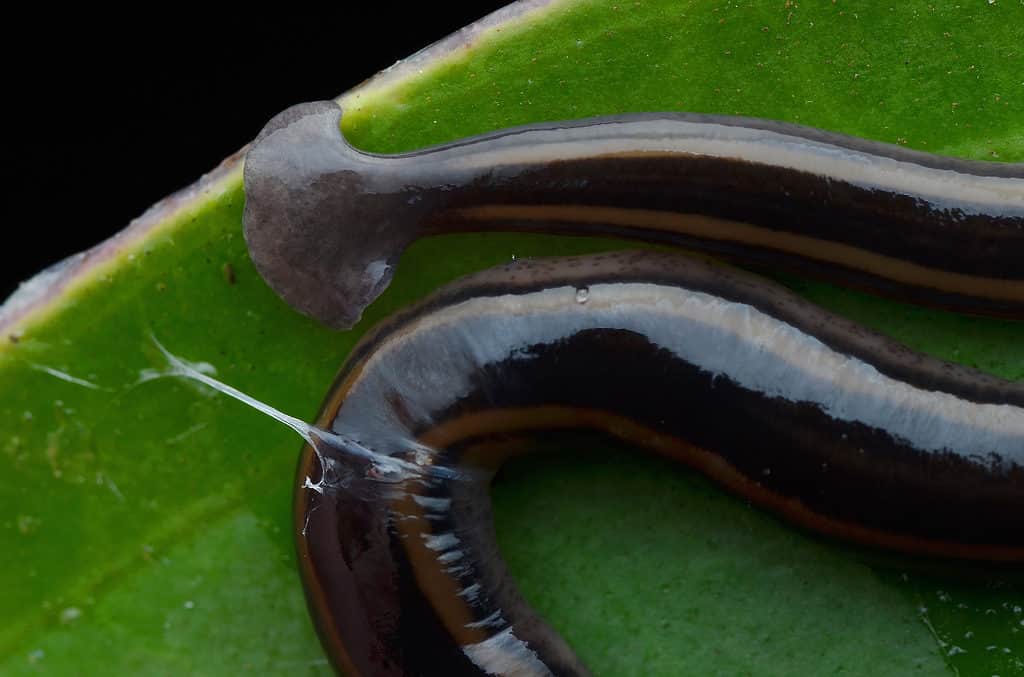Hammerhead Worm
Bipalium fuscatum
They are sensitive to light and prefer cool, dark, moist areas.
Advertisement
Hammerhead Worm Scientific Classification
- Kingdom
- Animalia
- Phylum
- Platyhelminthes
- Class
- Turbellaria
- Order
- Tricladida
- Family
- Geoplanidae
- Genus
- Bipalium
- Scientific Name
- Bipalium fuscatum
Read our Complete Guide to Classification of Animals.
Hammerhead Worm Conservation Status
Hammerhead Worm Facts
- Prey
- Earthworms, snails, slugs
- Main Prey
- Earthworms
- Fun Fact
- They are sensitive to light and prefer cool, dark, moist areas.
- Most Distinctive Feature
- spade-shaped head
- Distinctive Feature
- Dark dorsal stripes
- Other Name(s)
- Broadhead planarians
- Habitat
- Forests and gardens
- Diet
- Carnivore
- Type
- Flatworm
- Common Name
- Hammerhead worm
- Special Features
- Toxic secretions
- Origin
- Southeast Asia
- Number Of Species
- 62
- Location
- Asia, Europe, North America
View all of the Hammerhead Worm images!
“They possess a neurotoxin called tetrodotoxin, which is also found in pufferfish.”
Summary
The hammerhead worm (Bipalium fuscatum) is a land flatworm native to Southeast Asia and later introduced to Europe and North America. They hitch a ride on horticultural plants and escape greenhouses, eventually infesting gardens and forests. These worms are an invasive species because they secrete powerful neurotoxins and prey on earthworms. Discover everything there is to know about the hammerhead worm, including where you can find them and how to get rid of them.
4 Amazing Hammerhead Worm Facts
- Classrooms used to dissect hammerhead worms in Louisiana due to their abundance.
- They are sensitive to light and prefer cool, dark, moist areas.
- Hammerhead worms don’t like being dry and will coil into a tight ball, coating themselves in thick mucous.
- Their toxins can make humans and pets sick if touched or ingested.
Scientific Name
Hammerhead worms (Bipalium fuscatum) belong to the Tricladida order in the Geoplanidae family, encompassing land planarians (flatworms). There are currently 62 species in the Bipalium genus. The word is Latin for “shovel” or “spade,” referring to its pickaxe-shaped head.
Appearance

Their toxins can make humans and pets sick if touched or ingested.
©SIMON SHIM/Shutterstock.com
This worm gets its name from the shape of its head, which resembles a hammerhead shark. Although, it is rounded and looks more like a spade. They have snake-like bodies, reaching up to 15 inches long (eight to 12 inches on average). These species are typically light brown, with dark dorsal stripes going down the length of their narrow body.
Evolution and History
Hammerhead worms were introduced to the United States in 1901 when they were brought over on horticultural plants. They were so abundant at one point that Louisana classrooms used their bodies in zoology classes. Today they still regularly escape from greenhouses.
Behavior
These worms are primarily active at night as they are sensitive to light. They are carnivorous and cannibalistic and spend their days entangling creatures in slimy secretions. And they slide around on the ground on a trail of mucous, moving their hammerheads side to side. They use chemoreceptors on their heads to sense mucous from their prey. These worms like cool, dark, and moist places. They can’t stand being dry and will curl up into a mucous-covered ball.
Their slimy secretions are toxic and meant to ward off predators but humans and pets often come in contact with them, which can irritate the skin and cause other symptoms. They possess a neurotoxin called tetrodotoxin, which is also found in pufferfish. Touching or ingesting hammerhead worms can cause abdominal pain, headaches, numbness, and vomiting.
Habitat
They are native to southeast Asia in Vietnam but an introduced species to Europe and North America, particularly the United States and Canada. They live on horticultural plants, thriving in greenhouses before dispersing in the wild. These worms prefer hot and humid environments and live in tropical and subtropical regions. You will mainly find them in forests and gardens, where they hide under leaves, rocks, shrubs, logs, and anywhere else out of the beaming sun. The best time to spot them is after a downpour when they are visible on the topsoil and sidewalks.
Diet
The Bipalium species is predatory and feed primarily on earthworms and mollusks. But they may also consume slugs, snails, and insects. Hammerhead worms track their prey and capture them by using their body muscles and a sticky secretion that prevents the earthworm from escaping. To feed, they secrete enzymes that liquify the prey. The tissue is then sucked into the hammerhead’s gut.
Predators and Threats
The hammerhead worm has no known natural predators or threats. But they pose several threats to the environments in which they live. They prey on earthworms, which are essential to the health of compost, gardens, crops, and forests. These worm species can also cause skin irritation in humans and pets. Plus, they also carry parasitic nematodes. And while most nematodes are harmless, some can be destructive to plant life.
How To Get Rid of Hammerhead Worms
Officials recommend proper disposal of hammerhead worms.
- Use a stick, gloves, or paper towel to grab the worm and place it in a resealable plastic bag. If you accidentally touch it, ensure you wash and disinfect your hands immediately.
- Apply salt or vinegar directly on the worm while it’s in the bag. Then, seal the bag and place it in the freezer for 48 hours. It should dissolve.
- Toss the sealed bag in the trash
- Do not attempt to cut the worm into pieces as a way of killing it. This species regenerates, so you will only make the problem worse.
Reproduction and Life Cycle
Hammerhead worms are hermaphroditic, but researchers have yet to witness their sexual reproduction. But their egg capsules have been found, and they hatch around three weeks. They are also asexual and primarily reproduce in this manner. A small rear portion of the worm pinches off and develops a head within 10 days. This process occurs a few times a month. The hammerhead worm is practically immortal due to its neverending fragmentation.
Population and Conservation Status
The IUCN Red List of Threatened Species has never evaluated the hammerhead worm, but its population does not seem to be suffering. There are no known threats to the hammerhead worm. And they are considered an invasive species.
Related Animals
View all 104 animals that start with HHammerhead Worm FAQs (Frequently Asked Questions)
Are hammerhead worms harmful to humans?
Hammerhead worms secrete a neurotoxin, causing skin irritation when touched. If animals ingest them they can get headaches, numbness, and abdominal pain.
What do I do if I find a hammerhead worm?
Use gloves or a paper towel to pick it up and place it in a plastic bag. Pour salt or vinegar over the worm, seal the bag, and place in the freezer for 48 hours. Finally, dispose of the bag in the trash.
Do hammerhead worms bite?
No, they do not bite. But you shouldn’t touch one.
What happens if you cut a hammerhead worm into 10 pieces?
Each piece will regenerate and grow into 10 fully functional worms.
What eats hammerhead worms?
Hammerhead worms have no known predators.
Thank you for reading! Have some feedback for us? Contact the AZ Animals editorial team.
Sources
- , Available here: https://onlinelibrary.wiley.com/doi/full/10.1111/ddi.13489
- , Available here: https://hal.archives-ouvertes.fr/hal-03579225/document
- , Available here: https://peerj.com/articles/4672/
- , Available here: http://www.tsusinvasives.org/home/database/bipalium-kewense

















